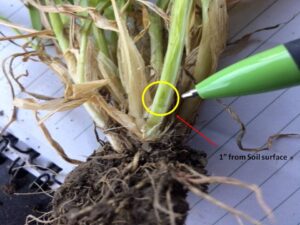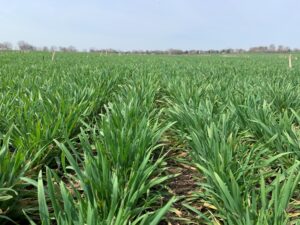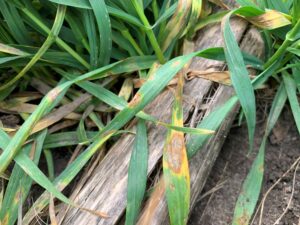The field season is well underway with much of the nitrogen on winter wheat, spring cereals being seeded and herbicide, fungicide and plant growth regulator (PGR) applications planned for the coming weeks. And yes, it is only April 16th! The early spring brought a lot of excitement to the wheat crop with the recent rains being welcomed to help slow the pace.
Many are commenting this is one of the earliest springs they can remember, so the question is, are we early and by how much? When looking at Growing Degree Day (GDD) accumulations (a weather-based indicator for tracking and predicting cereal growth and development) since March 1st, accumulations are well above the 9-year average in many areas (Table 1). This would be why many early-planted fields are at or approaching Growth Stage (GS) 30 and why paying attention to growth stage rather than the calendar date is important.
Table 1: Growing Degree Day (GDD) Accumulations since March 1, 2021 compared to the 9-year average.
| Location | GDD Accumulations March 1 – April 15, 2021 | 9 Year Average March 1 – April 15th |
| Windsor | 285.05 | 189.87 |
| Ridgetown | 284.9 | 144.33 |
| London | 280.15 | 115.9 |
| Elora | 224.64 | 63.64 |
| Mount Forest | 237.3 | 50.72 |
| Cobourg | 193.05 | 86.68 |
| Kemptville | 225.3 | 60.98 |
| North Bay | 177.1 | 10.24 |
Source: https://farmwest.com/climate/calculators/growing-degree-days/
Identifying GS 30 and Management Considerations
GS 30 is important in winter wheat because this is when plants shift from vegetative to reproductive growth. All meaningful tillering has been completed and the main stem and tillers start to synchronize. This stage is critical for nitrogen applications in order to influence the number and size of seeds on the head. This stage is also the beginning of the optimum window for PGR applications. Many early-planted fields are at or approaching this growth stage. Later-planted fields in Ontario are still at the tillering stage.
To identify this growth stage, plants need to be sliced open along the stem. When the plant has been sliced open you should be able to see the developing head about 1/4” above the crown (Figure 1). The wheat will also have a more upright appearance (good posture) (Figure 2). This video starting at 15:20 demonstrates how to identify GS 30: https://www.youtube.com/watch?v=8U4iCySf9r4.


PGR Application Timing
While currently available PGRs have a relatively wide window of application on their labels, the optimum window for application of these tools is GS 30-32 (the beginning of stem elongation). The use of a PGR will bring the most benefit to a winter wheat crop when:
- You have an early planted winter wheat crop with lots of growth
- You are growing a variety that is prone to lodging
- You can determine the lodging potential of your variety by visiting GoCereals.ca
- Your winter wheat field has a history of manure applications with good fertility
- You are implementing an intensive wheat management program (i.e. early planting, high seeding rates, aggressive nitrogen rates (150 lbs/ac +)) and have a high yield potential
When tank-mixing PGRs with herbicides and fungicides, ensure that you are following the label for each product and that the weather conditions are suitable for application. The manufacturer of each tank-mix partner should also be consulted for assurances. Adding more to the tank does increase the risk for injury, so if possible, avoid a 3-way mix or ensure you are increasing water volumes to at least 20 gal/ac. While PGRs are relatively safe if temperature lows reach 1C, when tank mixing with herbicides, growers should wait for warmer temperature lows before making those applications.
If you are interested in trying PGRs on your farm please consider the following PGR Protocol and reach out to Joanna Follings. More information on PGRs currently available and their fit within your system can be found here: https://fieldcropnews.com/2019/06/plant-growth-regulators/.
Early season diseases and fungicide applications
Septoria has begun showing up in winter wheat fields (Figure 3). In those fields with a dense canopy, the symptoms are appearing on old growth at the bottom of the canopy. There is little economic benefit to fungicides prior to GS 31-32, so continue to scout fields and monitor for disease movement up the canopy. With some rainfall in the forecast fields should also be monitored for powdery mildew. OMAFRA Publication 812, Field Crop Protection Guide, 2020-2021.

Considerations for Herbicide Applications
Ideally, herbicide applications should be done by GS 32 or the second node. Although many herbicides can be applied up to early flag leaf, when they are applied before GS 32, annuals have often emerged and the risk for injury to the crop is relatively low. Once we get beyond this growth stage the benefit to a herbicide application goes down and the risk for injury goes up. If you are experiencing higher levels of winter annuals, the sooner an application can be made the better. If you are targeting annual weed species such as lambsquarters and common ragweed, those weeds are just starting to emerge. In thick wheat stands they will not compete strongly against the crop. With nighttime temperatures dipping down, many are opting to hold off on herbicide applications until temperature lows are at least 3C the day before, the day of, and the day after application. Publication 75A: Guide to Weed Control, Field Crops 2021 : 7. Cereal crops.
Correcting Manganese Deficiency
Due to the relatively dry conditions this spring, manganese deficiency has shown up in a number of winter wheat fields. Manganese deficiency is most commonly found on high pH, sandy soils or muck soils. Manganese sulphate should be applied as soon as possible at 7 lb/ac in 53 gal of water with a spreader-sticker to correct the deficiency. Products that are a “shotgun blast” of nutrients are not recommended as they are often applied at very low rates requiring multiple applications Agronomy Guide for Field Crops (Page 135).

Comments are closed.